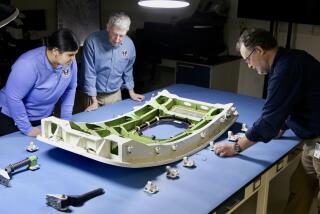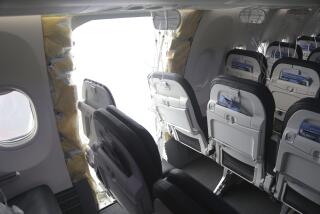Pan Am Jet’s Pressure Loss Blamed on Valve Door
- Share via
A small valve door that came off during flight was responsible for the loss of cabin pressure that forced a Pan American World Airways jumbo jet to dive sharply over New Mexico and return to Los Angeles International Airport, an airline spokesman said Saturday.
Pan Am spokeswoman Susan Timper said officials have not yet determined what caused the small outflow valve door to come off Friday evening. The 30-inch-by-18-inch door normally opens and closes in flight to help regulate the aircraft’s cabin pressure.
“That’s something for investigators who are examining the airplane to determine, and we may not know for another few days,” Timper said.
After the London-bound plane sustained a sudden loss of cabin pressure, the pilot put the airliner into a steep dive from 29,000-feet before returning to Los Angeles, where the plane landed safely.
There were no injuries reported among the 133 passengers and 14 crew members aboard Pan Am Flight 120. Pan Am officials said all of the passengers continued their flight aboard another Pan Am plane Friday night.
The officials provided few details about the incident, and declined to identify the pilot or the age of the Boeing 747 aircraft.
A spokesman for the Federal Aviation Administration said that FAA and Pan Am investigators, who examined the aircraft Friday, were not finished with their investigation, and that the plane would remain inside a hangar at LAX until the investigation was completed.
The outflow valve door is located underneath the aft portion of the Boeing 747. Timper called its disappearance in flight “extremely rare.” Craig Martin, a spokesman for Boeing, said that he was “unaware of any historical problem” with outflow valve doors on other Boeing 747 aircraft.
Timper said that the airplane “was in the full control of the captain at all times” and that the passengers and crew were never in serious peril.
However, a veteran commercial airline pilot said that, by requiring a sudden emergency descent, the incident was “potentially dangerous.”
“Any time you have to leave an assigned altitude that is your private airspace and charge through everybody else’s airspace without waiting for clearance, there’s the potential for midair collision,” the pilot said.
Last February, failure of a cargo door caused explosive decompression aboard a United Airlines Boeing 747 near Hawaii, tearing a hole in the side of the fuselage through which nine people were hurled to their deaths. The plane was able to land safely in Honolulu.
In 1985, failure of the aft pressure bulkhead on a Japan Airlines Boeing 747 caused sudden decompression that crippled the plane’s controls, causing it to slam into a mountain north of Tokyo, killing 520 in the worst single airplane disaster in aviation history.
More to Read
Inside the business of entertainment
The Wide Shot brings you news, analysis and insights on everything from streaming wars to production — and what it all means for the future.
You may occasionally receive promotional content from the Los Angeles Times.










